Annecy, France
When we told our friend Andra Duke that we were going to Geneva, Switzerland, she said that her favorite thing near there was the charming town of Annecy, France, which was just 45 minutes away. So we took her advice and spent a day there.
Kelly was working that day and Maria was busy and had her choir practice that afternoon, so they let us borrow their car and we drove over the border to France.
Their car was magic. It had a great navigation system that would show an overview of the trip in one screen, a closer-up view below the dash, and a heads-up display with a diagram of what you needed to do at the next exit, traffic circle or intersection. The heads-up display also showed your current speed and the current speed limit, which it apparently detected via a camera as you drove along. And to top it all off, the cruise control not only had radar to keep you from getting too close to the car in front of you, but it would also automatically adjust your speed to the speed limit as it changed, even in town.
Switzerland is big on following the rules, and you don't speed there. If you do, a camera will take your car's picture and mail you a ticket. As a result, almost everyone just goes the speed limit, and it's fine. So having a car that would magically do that for us was awesome. As a 7-passenger SUV, it was a little larger than some cars there, but still smaller than an American SUV would be. Anything bigger would be difficult to park.
When we got to the lake, we looked at various options, and then decided to rent a little motor boat for an hour. You had to go "really slow" until you reached the buoys, and then you could crank it all the way up to "pretty slow." (They don't want to trust tourists with something that can go fast enough to get anyone hurt). But it was fun just to get out on the lake.
It was fun to go explore the little villages around the lake from the water.
We saw a rowing team doing some practicing.
There were rugged mountains in the distance that looked cool.
Here's a 40-second video of the view on the lake, and of someone doing some wake surfing on another boat.
A bunch of little sailing paddle boards were on the lake when we returned.
We stopped for a moment on the famous Pont des Amours (Bridge of Lovers).
Then we walked over to the Jardins de l'Europe (Gardens of Europe), where there were pretty flowers, and some trees that were over 100 years old.
This statue honored Claude Louis Berthollet, who was a chemist born near Annecy and who was the first to demonstrate the bleaching action of chlorine gas. It's comforting to know that sometimes people think scientists are cool, too.
We walked along the river and found a cafe where we stopped for lunch. Food appears to cost about half as much there as in Switzerland. (Switzerland uses its own currency, Swiss Franks, instead of the Euro; and requires stores to stock a large percent of Swiss-made goods. The lack of trade does tend to make prices high, but also maintains a high degree of independence and self-sufficiency.)
After lunch we walked over to the Palais de L'Isle (Palace of the Isle). It is a fortified house originally built in the 12th century, and has at various times been used as a house, prison, courthouse and administrative center.
This part of town was the "old town", and it was charming, with its river, bridges, old buildings, narrow streets, and arches.
We walked up the above stairs and arrived at the Château d’Annecy, which is a castle and museum.
Here is the main courtyard when you walk through the gates. The castle was built between the 12th and 16th centuries, and was the residence of the Counts of Geneva and the Dukes of Genevois-Nemours. It suffered from several fires and was abandoned in the 17th century, and then the town acquired it in 1953 and restored it and turned it into a museum.
On one side of the castle is an observation area with a great view of the lake and the town.
Inside, there were spiral staircases going up several floors.
Here is a model of the castle that we found inside.
There are paintings and some sculptures throughout the castle.
I zoomed in on one part of the above painting and you can see the detail below.
And then we went up further.
There was a little boat-shaped bench there that said "Open to play."
One person could sit on each end, and play a game of "Memory" with various fish inside. The names of the fish were in French, of course.
We enjoyed talking to a kid and his family who were from Italy. We kept bumping into them in more rooms, and they didn't speak any English, but we communicated a little about where we were all from and how we visited Italy last year and such.
There was also a modern art display, but it all seemed silly so I didn't take pictures of that.
We enjoyed the museum, and then headed out.
Another item on my list of things to check out in Annecy was a famous ice cream place called Glacier des Alpes.
There was a long line there, but we persevered. While in line, we had a nice time talking with a gal from Ireland who is teaching English in France. I love Irish accents!
I also love Linette. And ice cream.
This is the Église Saint Maurice, a Gothic Roman Catholic church originally built in 1422.
I liked this structure in the garden made out of random-angled wood.
We picked up the car and drove up to the "Semnoz," where I had heard there was a great hike. The hills we drove up were thickly forested and the drive was beautiful, often like driving through a tunnel of trees.
We saw some people feeding some reindeer, so we pulled over there to check it out.
A little further up, there were a bunch of goats in another area. This one had a creepy smile.
From there, we just started hiking, and were rewarded with some great views of the city below.
In this section, the dirt had worn away, exposing so many roots of the trees. It's strange to think that this is how the roots look everywhere else, too, just under the surface.
We really loved the hike there.
We walked through some deserted trails, and eventually got back to our car, and then drove back to Geneva, arriving just after dark.
That evening we had fun talking with Kelly and Maria (after she returned from her choir rehearsal). We also got to hear what their son David had learned after taking guitar lessons for a while. He had some pretty cool riffs going.
Lausanne
In our original schedule, we planned to go to the town of Charmonix, and from there take a gondola or train up the mountain to see the Aguile du Midi, where you get a great view of the famous Mont Blanc. However, we had already done something similar in Zermatt, and it was cloudy that day, so chances were slim that we'd be able to see anything.
So Maria said that if we liked the Olympics (and we were indeed big fans) that she would recommend seeing the Olympics Museum in Lausanne, which is a town along the coast of the lake, about 45 minutes from Geneva. So we again borrowed their magic car and off we went.
Along the way, we saw some more of those yellow fields I loved so much (which were a bit more subdued on a cloudy day).
Then we located Le Musée Olympique and headed inside.
This model showed some of the original buildings used in the ancient Olympics, according to archeological evidence.
There was a lot of information about Pierre de Coubertin, a guy from France who spearheaded the revival of the Olympic Games and the associated Olympic Movement. He noticed that British schools had physical education, which gave their population something that the French seemed to lack. So Pierre worked to get that going in France as well, and thought the revival of the ancient Greek Olympic Games would be just the thing to get people's attention.
The first Olympic games in over 1500 years were held in 1896 in Athens, Greece, with 14 nations participating. Since then, it has been held in many places, including the Winter Olympics in Salt Lake City in 2002. I remember going downtown and attending the pairs figure skating finals in person when the Olympics were in town, and that was a magical time.
Here are some of the torches that have been used throughout the years. Every year the torch is lit in Olympia, Greece, in a reenactment of the ancient ceremonies. From there, it is carried by a series of runners around the world until it enters the stadium during the opening ceremony.
This is a torch for the Salt Lake City Olympic games in 2002.
I remember when we went to Draper, Utah to watch the Olympic torch go by in 2002. We stood there for an hour, and then, unfortunately, one of our kids had to go to the bathroom, and while I was in Arctic Circle taking care of that, the torch went by.
So when I got to work afterwards, we recreated the moment using a candle I had laying around. It just goes to show that everything is more awesome if done in slow motion with the Olympic Fanfare playing.
I named the video, "The Passing of the Torch" (pun intended, since it passed by without me seeing it).
The headquarters of the Olympic Committee was originally in Paris, but moved to Lausanne in 1915 when World War I put France in turmoil.
The passageway to the next floor down indicated that we would be learning about the games of the Olympics.
As you can see from this angle, the words were painted as a bit of an optical illusion.
There were some stations with lots of Olympic stories. I love this one about how the runner Betty Robinson was discovered.
There was a fun video screen that showed lots of winter Olympics events at once.
Then there was modern equipment that looked awesome. Maybe it will look old-fashioned to future generations.
They also displayed medals from various years, including these medals from 2002.
We watched little videos, and kind of got that Olympic feeling as we read stories, heard interviews, and watched videos of some of the great moments. I learned that athletes used to have to just find a hotel room or something, but that eventually an Olympic Village was built at each venue to house and care for the athletes.
After 3 hours there, our parking meter was expired, so we had to do a 400m run to get to the car. But we felt like we had been victorious in our exploration of this Olympic Museum.
From there, we decided to explore the town of Lausanne a bit. We parked on a random corner and then walked up the hill to see what we could see. We saw the Château St-Maire, a castle from the early 1400s that has been serving as a government building for the last couple hundred yeras.
Then we walked over to see the Lausanne Cathedral.
Still, just the arches, pillars and open spaces are beautiful on their own, and tend to draw one's mind heavenward.
And the stained glass was beautiful.
There was a tall spiral staircase that went up. There are apparently 153 steps, and I believe it.
The spires there tend to be impressively tall and pointed.
Linette and I climbed up to the very top level where we got a great view. (Linette may or may not have been the one who swung the clapper in the bell until it rang loud enough for the entire town to hear.)
We found a bakery where we got a sandwich and a salad, and then sat down inside and ordered drinks as well.
When I was finished, I went and grabbed a tangy frozen yogurt at "llao llao" (pronounced "yow yow") across the cobblestone street. (Shaylee recommended these from her time in Spain, and Isabel also loves it).
On our way back to Geneva, we pulled over in the town of Morges to visit the free Tulip Festival.
The variety of colors was amazing.
We wandered through the flowers in the general direction of the lake.
We took a moment to dangle our feet off of the wall overlooking the lake. As the saying doesn't go, "Sometimes you have to stop and stop smelling the tulips."
A wooden path led up to an observation deck.
FLOWERS!!
There was a cute "hideout" area surrounded by trees, where we saw some little kids playing for a while.
Finally, we headed back to Geneva once again.
It was fun having a couple days out on our own. In the next episode we explore Geneva a bit, and then visit a tiny ancestral town of Weiach.
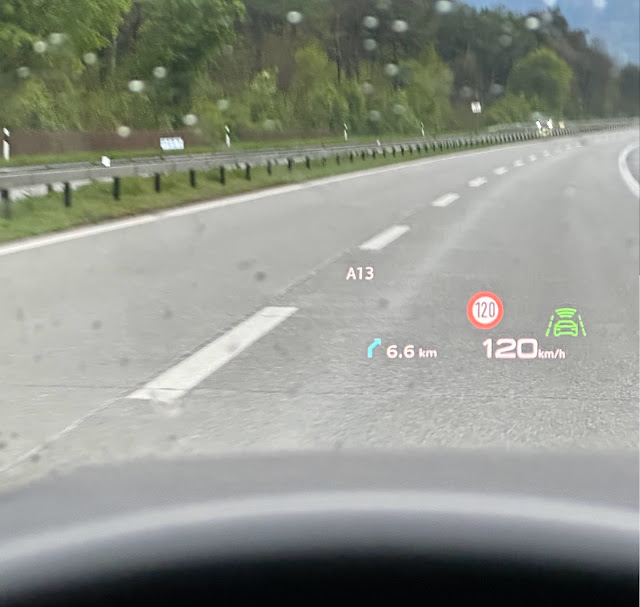














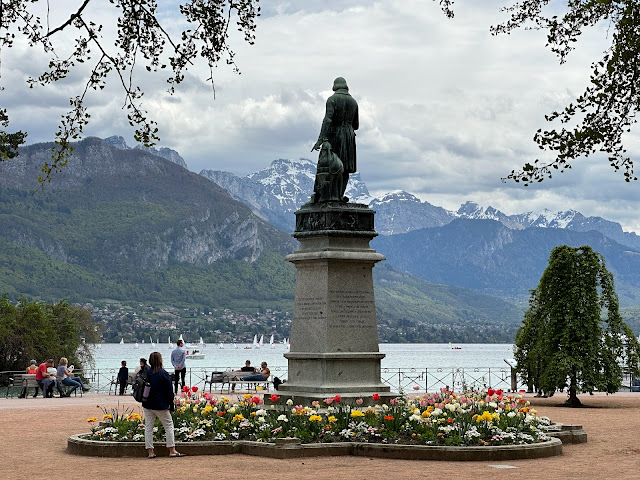
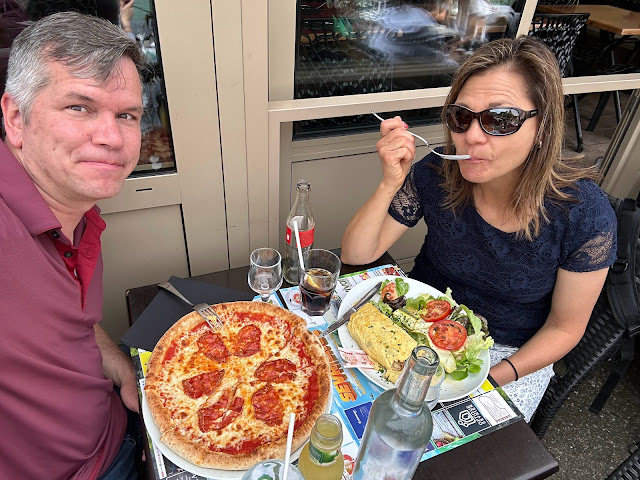
















































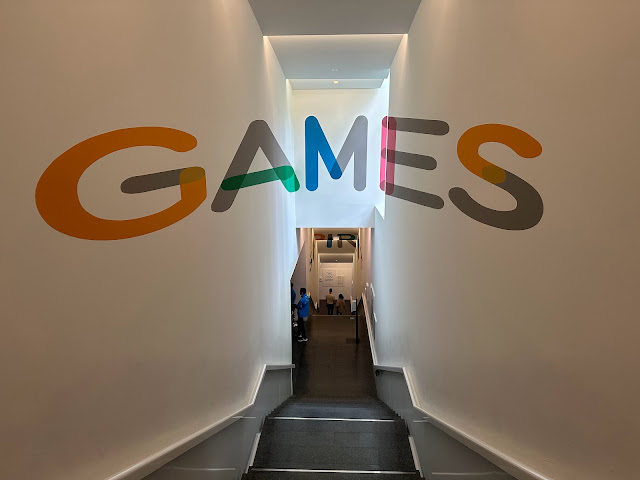





















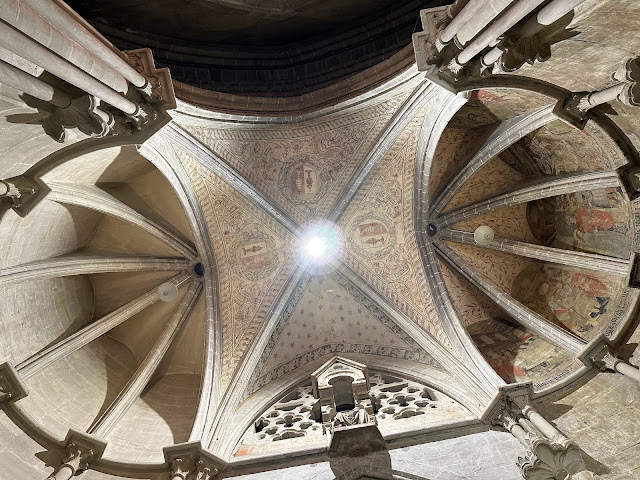






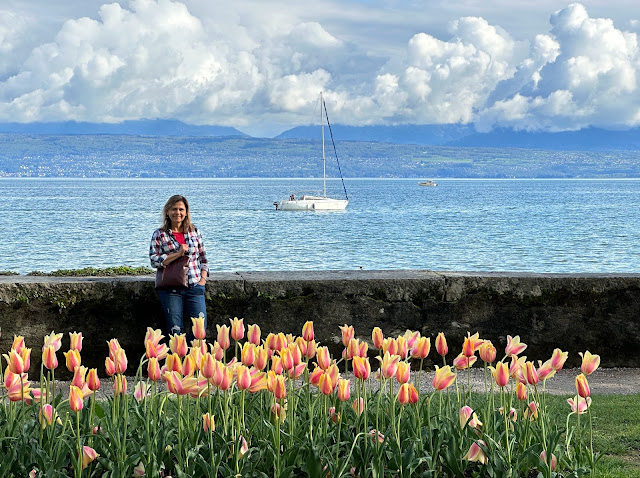
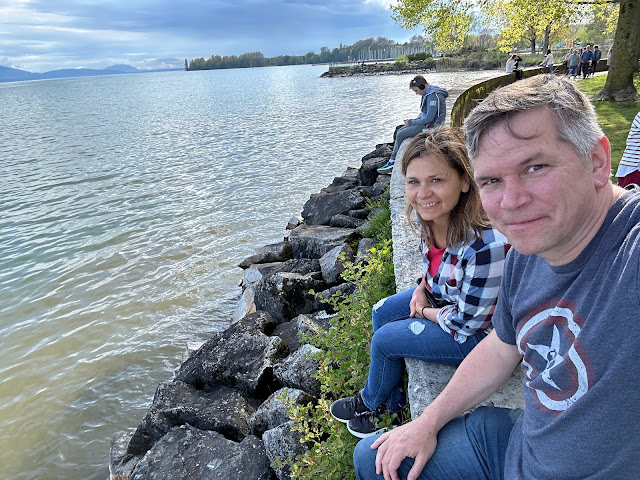






No comments:
Post a Comment